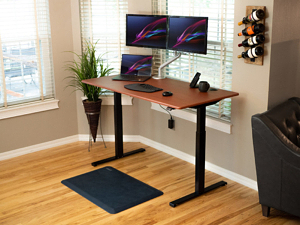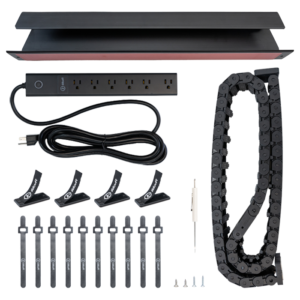What to Expect When You’re Expecting Your First Standing Desk
Like most reviews sites, our editorial staff and laboratory testing expenses are partially offset by earning small commissions (at no cost to you) when you purchase something through those links. Learn More

Over the years we’ve helped hundreds of thousands of users create their first standing desk office — and for that matter, over a million site visitors a year read our reviews and advice. So we tapped our review staff veterans for their favorite pro tips for new users looking to optimize their standing desk experience, and collected them all here. This is also a good document to review before purchasing your standing desk, to make sure you’ve thought through all the issues around placement and ergonomics. We’ve included links to our most popular advice articles for deeper dives into some of the topics below.
Note that if you’re thinking of adopting an underdesk office treadmill to tuck under your standing desk, or going directly to a treadmill desk, you might want to click over to our primer on What to Expect When You’re Expecting Your First Treadmill Desk as it includes all the advice you’ll find below.
Analyze Your Space Before You Buy
-
It’s always a good idea to accurately measure out the space where you plan to have your new standing desk before you rush to order a desk that’s just a little too small or a little too big to fit. It’s also good to think through how much room you will need to maneuver around the desk, not only while working at it, but also when setting it up.
- If your new desk isn’t replacing an existing one, you’ll want to make sure that where you place it isn’t going to create a screen glare problem from open windows or bright lights.
- While most standing desks are sold “by the foot” in common sizes like 48”, 60”, or 72” wide and most commonly 30” deep, some models are much more customizable than that and can take better advantage of your space. For example, iMovR desks are made-to-order on 6” increments in both width and depth, and even come in some unique corner, L and U configurations.
-

If you’re buying a desk that’s going to go into a cubicle be aware that a 4’ desk will not fit well in a 4’ cubicle. Look for desks that have a “pinch trim” (in this example 47”-wide to fit well in a 4-foot cubicle.)
- Most stand-up desks these days also come in a variety of finishes, so take a good look around the room and think about which base colors and desktop finishes will look best in your office. There are numerous options in terms of desktop materials — from old school high-pressure laminate (HPL) to luxurious (and pricier) solid wood. Be sure to check out our complete guide to desktop materials before you go shopping. As a rule of thumb, the cheaper the desk the fewer options there’ll be for colors, and conversely the more upscale you go, the more sizes and colors you’ll be likely able to select from.
-

In adopting a standing desk you might be giving up desk drawers that you had before, so be sure to investigate the best options for adding drawers and other storage accessories to your standing desk or our round-up of the best standing desks with built-in drawers.
Assembling Your Workstation

- Most desks are sold as DIY kits that take as little as 15 minutes to as much as two hours to assemble, and you’ll need the space to assemble them. (An increasingly popular option for those who don’t have the space, skills, or patience to assemble their adjustable-height desk is to order one that is 95%+ factory pre-assembled—see our reviews round-up of the best quick-install standing desks). Either way, when you unbox the desk, you’re going to need to lay the desktop upside down on the floor or another desk in order to pop the legs in, and then flip it over. If doing this on the floor we always recommend thoroughly vacuuming the assembly area, and laying down a thick blanket to protect the desktop surface as you work on attaching the base to it.
Workstation Placement
- Make sure your stand-up desk is on firm footing — solid floors or low-pile carpets are best. Avoid placing them on a deeply-padded, plush, or shag carpet. Remember: Most floors are uneven. IMPORTANT: Adjust the leveling feet on the standing desk to ensure that all four corners of the unit are solidly on the floor, and no corner is “high sided.” Keeping the standing desk level is critical to protecting it from torsion stresses on the frame that can lead to excessive motor strain and squeaky legs, which can reduce the life expectancy of key components and potentially even void the warranty.
Optimizing Your Ergonomics

- When it comes to standing desk use, stability is king, whether you are using it on its own or with an under-desk treadmill or balance board. It may not be obvious to the uninitiated, but an overly shaky desk can significantly contribute to ergonomic problems. Adjustable height desks vary widely in their degree of shakiness, particularly at higher heights — and remember that if you use an office treadmill or balance board, it will increase your height even more. When 2-legged standing desks are taken to their maximum heights, the telescoping leg segments will have minimal overlap and shakiness will invariably ensue—this is just basic physics (note: stability concerns vanish with 3-legged and 4-legged workstations). There are numerous hacks for getting more height range out of your standing desk—which will increase its stability at any given height—e.g. by adding height extenders and/or caster wheels. Get all the details on this by reading our primer on why some standing desks wobble more than others. For those who are over 5-foot-9 in height, check out our additional tips for taller users.
- Using an ergonomic monitor arm is absolutely essential for standing desk users. The reason is that each time we stand up our lower spine stretches out and so we wind up craning our necks down a bit to look at the screen compared to what was a comfortable screen height when we are seated. Check out our monitor arm ergonomics primer and reviews round-up of all the best monitor arms for standing desks. Alternatively, some people prefer to use a monitor riser rather than an articulating monitor arm. Learn about the pluses and minuses by reading our primer and reviews round-up of the best monitor shelves for standing desks.
- Similarly, keyboard trays that worked well on fixed height desks may come up short when used on a standing desk, if they can even be installed without running into the crossbar underneath the desktop. Check out our keyboard tray ergonomics primer and review round-up of all the best keyboard tray options for standing desks.
- Use a standing mat. A good standing mat can literally triple the amount of time you can stand comfortably each day, among other health benefits. If you are just on a hard floor while you use your standing desk, your feet will hurt sooner and you’ll want to sit, reducing your standing time and the value you put into your desk. Be sure to check out our reviews round-up of the best anti-fatigue mats for use with a standing desk.
- You won’t be on your feet the entire day while using a standing desk. You are going to have to sit at some point so you won’t put too much strain on your feet or knees (more on that later). But while you sit, make sure you get a chair or stool option that continues to help your posture and ergonomics. Our experts have compiled a healthy list of seating options for standing desk users.
Other enhancements
-
All the cables running from your desktop to the floor can become an unwieldy monster, and quite unsightly, if not tamed. Check out our experts’ advice article on taming the cable snarl, and these convenient and versatile cable management kits.
- Many people struggle with the loss of their file drawers when switching to an adjustable height desk, which is why many desk manufacturers offer matching mobile file pedestals to go with their standing desks. The nicest ones will be heavy—so they won’t tip over when opened—and be made to match the lamination of your desk or, if metal, the paint color of your base. If they are sturdy enough, they can also double as wheeled stools for when an impromptu guest visits your workspace and you don’t have an extra chair handy. Check out our round-up of the best storage options for standing desks, including matching file cabinets and drawers.
- There are numerous after-market products for bringing power and data plugs up to the desktop for easy access. We particularly recommend these for shared standing desk workstations where multiple users will be coming over with laptop in hand, and you don’t want them groping around on the ground for outlets to plug in their laptops and mobile devices. Some desk manufacturers offer flush-mounted modules that fit perfectly in the grommet holes provided in their desks, while others are typically edge-clamp mounted. Check out our round-up of power accessories for standing desks.
- Another aspect to think about when you might want enhancements for your desk is grommet holes. Check out our article on grommet holes, with everything you need to know about the different ways to use them to enhance your workstation, what to look for in your grommet holes, and where to find the desks with the best ones.
Tax & Legal Considerations

- Your new workstation is probably tax deductible, just like any piece of office furniture, provided it is used for business purposes. Consult your tax adviser but read our experts’ advice first.



0 Comments
Leave a response >